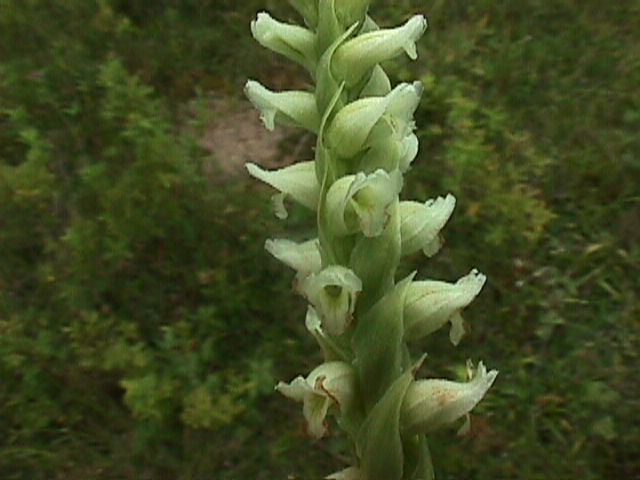This native perennial
plant is usually 4-12" tall and unbranched. There is a rosette of 3-6
strap-like basal leaves that are individually about 4-8" long and 1/3"
across. They are linear to linear-oblanceolate with smooth margins, and
usually wither away before the flowers bloom. On robust specimens, there may
be 1 or 2 small leaves on the lower flowering stalk. The flowering stalk is
up to 1' tall, with 6-12 flowers occurring on the upper half. These flowers
are arranged on the stalk as intertwined double spirals – as a result, the
individual spirals are not readily discernible. The flowering stalk is light
green and covered more or less with white glandular hairs. At the base of
each flower, there is a conspicuous green bract that is curved and narrowly
ovate. Each flower is about 1/3" long, consisting of 3 white sepals and 3
white petals. The upper sepal and upper two petals are fused together and
form a curved hood that curls upward at its tip, forming a small upper lip
with 3 lobes. The lower petal has a prominent lip that hangs downward and
has a crystalline appearance, while the lateral sepals are linear and
non-spreading. Together, these sepals and petals form a tubular-shaped
flower that nods downward. The blooming period can occur from late summer
until the fall, and lasts about a month. There is usually a mild floral
scent. Some plants may form cleistogamous flowers. Fertilized flowers are
replaced by pods containing the tiny seeds, which are easily carried aloft
by the wind. These pods may be capable of photosynthesis while they are
green. The root system consists of a cluster of fleshy roots at the base of
the plant that are finger-like in shape, and occasional rhizomes may be
produced. This orchid can reproduce from the seeds of the flowers, or it may
form offsets from rhizomes. Normal growth and development won't occur unless
the root system forms an endomycorrhizal association with the appropriate
species of fungus.
Back to
n Listing
Home


